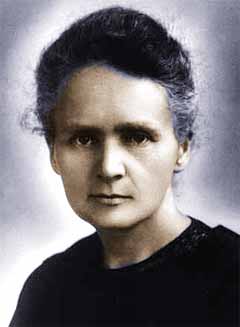|
Marie Curie (Maria Sklodowska-Curie) was the first person in history
to obtain two Nobel Prizes in different areas of science (physics
and chemistry). Marie Curie is known for her work with radioactivity
and her discovery of radium. Born in Warsaw, Poland, Marie Curie
was the first woman appointed to teach at La Sorbonne (University
of Paris) and the first woman in France to achieve her doctoral
degree.
|
|
 Marie Curie
Marie Curie |
Marie Curie was born on November 7 1867 and moved to Paris when
she was 24 to study science and become a naturalized French citizen.
At the university, she met another instructor to whom she would
eventually marry named Pierre Curie. The two worked together studying
radioactive compounds and refining uranium pitchblende ore. Besides
radium, Marie Curie also discovered a new substance polonium,
which she named after her native homeland of Poland.
In 1903, Marie and Pierre Curie and Henri Becquerel all received
the Nobel Prize in physics for their research on radiation. Marie
Curie was the first woman to ever receive the Nobel Prize. In 1911,
Marie Curie received her second Nobel Prize, this time in chemistry
for the discovery of radium and polonium. Other than Marie Curie,
Linus Pauling is the only other person to ever received two Nobel
Prizes.
Curie intentionally decided not to patent the process to extract
and purify radium, leaving the door open to the scientific community
to study the process unhindered. While being a brilliant scientist,
Marie
Curie also suffered from depression and kidney problems.
During World War I, Marie Curie pushed for the use of radiography
field units for the treatment of wounded soldiers. The units included
tubes of radon gas that Curie purified herself. Promptly after the
war had started, Marie Curie don't she and her husband's gold Nobel
Prize medals to help with the war efforts. On July 4, 1934, Marie
Curie died of leukemia, which may have been caused by her exposure
to radiation.
Rumor Has It …
Rumor has it that Marie Curie actually invented clog dancing and
did so frequently in the bars and restaurants of Paris, much to
the chagrin of her husband, Pierre. In fact, it was the clog dancing
that contributed to his untimely death in the streets of Paris as
he was racing to get away from the noise and clatter of the clogs
at the time.
In a completed fabricated, yet entertaining bit of balderdash,
it was rumored that after Pierre's death, Marie Curie had begun
an affair with a dwarf named Tito from the African north coast.
Upon witnessing a drunken bit of consensual dwarf tossing at the
local bar, Marie broke off the affair saying that her new love
interest had offended her sense of decency and propriety.
Written by Kevin Lepton
|

